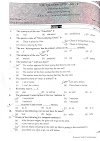Superposition of waves
Principle of superposition
When two or more waves overlap, the resultant displacement at any point and at any instant is given by adding the instantaneous displacements that would be produced at any point by the individual waves if each were present alone.
i.e.
Superposition of waves is off four types
i. Interference
ii. Beats
iii. Stationary waves
iv. Lissajous figures
If two sound waves of equal frequency and amplitude move in the same direction, then at points where they meet in same phase, intensity of sound become maximum (constructive interferences) and at points where they superimpose in becomes minimum (destructive interference). This variation of intensity of sound is called interference of sound.
-Let, and + superimpose. Then,
i) Phase difference =
ii) Resultant amplitude ,
-
-
iii) Resultant intensity ,
-
-
-When crest of one wave falls on crest of another wave.
-Phase difference (∅) between two waves = even multiple of π
i.e., ∅ = 0, 2π, 4 π, 6 π, 8 π ……
or, ∅ = 2nπ, where n = 0, 1, 2, 3, 4, ……...
and path difference between the waves,
∆x = integral multiple of λ
so, ∆x=nλ, where n = 0, 1, 2, 3, 4, 5, 6, 7, 8, ……...
-
-
-When crest of one wall on trough on wave.
∆∅=(2n-1)π
n = 1, 2, 3 ……
∆∅ = π, 3 π, 5 π …….. (odd multiple of π)
∆x = λ/2, 3λ/2 , 5λ/2, …….
-
-
Beats
When two notes (or sound waves) of nearly equal frequency travelling in same direction superpose each other at a given point, then the intensity of the resulting sound rises and falls periodically. The periodic rise and falls in intensity of sound at a given point is called beats
Time interval between successive maxima or minima is
The number of maxima or minima per sec or beat frequency = =
No. of beats / sec is called beat frequency and is given by . [ should not be more than 10 Hz]
Beat:
= a sin 2πt + a sin 2πt
= 2 a sin 2π ( + ) t / 2 cos 2π ( – ) t / 2
so, y = 2a cos ( – )πt. Sin2πft (≈ = f)
Or, y = A sin 2πft
Where, A = 2a cos π ( – ) (valid when ≈ )
Squaring both sides
f_1f_2
Tuning fork
It is made of ellinvar.
• It produces sound of a single frequency.
• Ellinvar has property in which neither Young’s modulus nor length changes with change in temperature.
• Waves produced in stem are longitudinal stationary while in prongs are transverse stationary.
• Frequency of tuning fork decreases if it is loaded and increases if it is filled.
• Prongs of tuning fork always vibrate in opposite phase [i.e., ∅ = π]
Echo and Reverberation
-It is the sound heard after reflection from an obstacle.
-To hear an echo of a sharp sound, the time interval between original sound and reflected sound ≥ 1/ 10 sec.
∴ minimum distance x of obstacle from the source should be
x+x = v * 0.1 = 330 * 0.1 = 33
∴ x = 16.5 m
-If first and second echo from the reflecting surface is heard after time and , the third echo will be heard after = sec
-The persistence off hearing is 0.1 second. So, if reflected sound reaches to speaker (observer) within 0.1 s after its reflection from distance surface, the original sound is prolonged and echo is not heard. This is called reverberation.









0 Comments